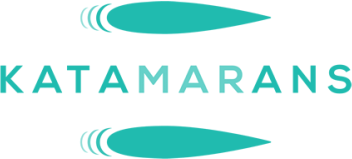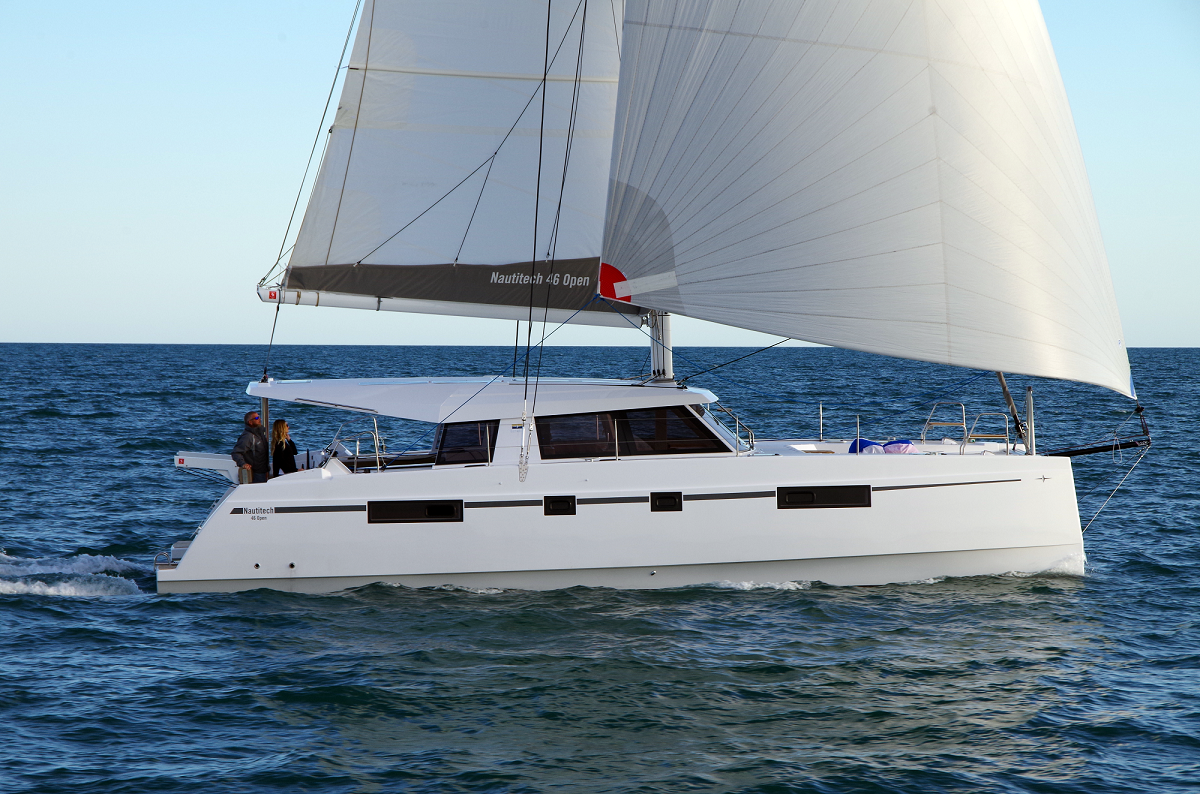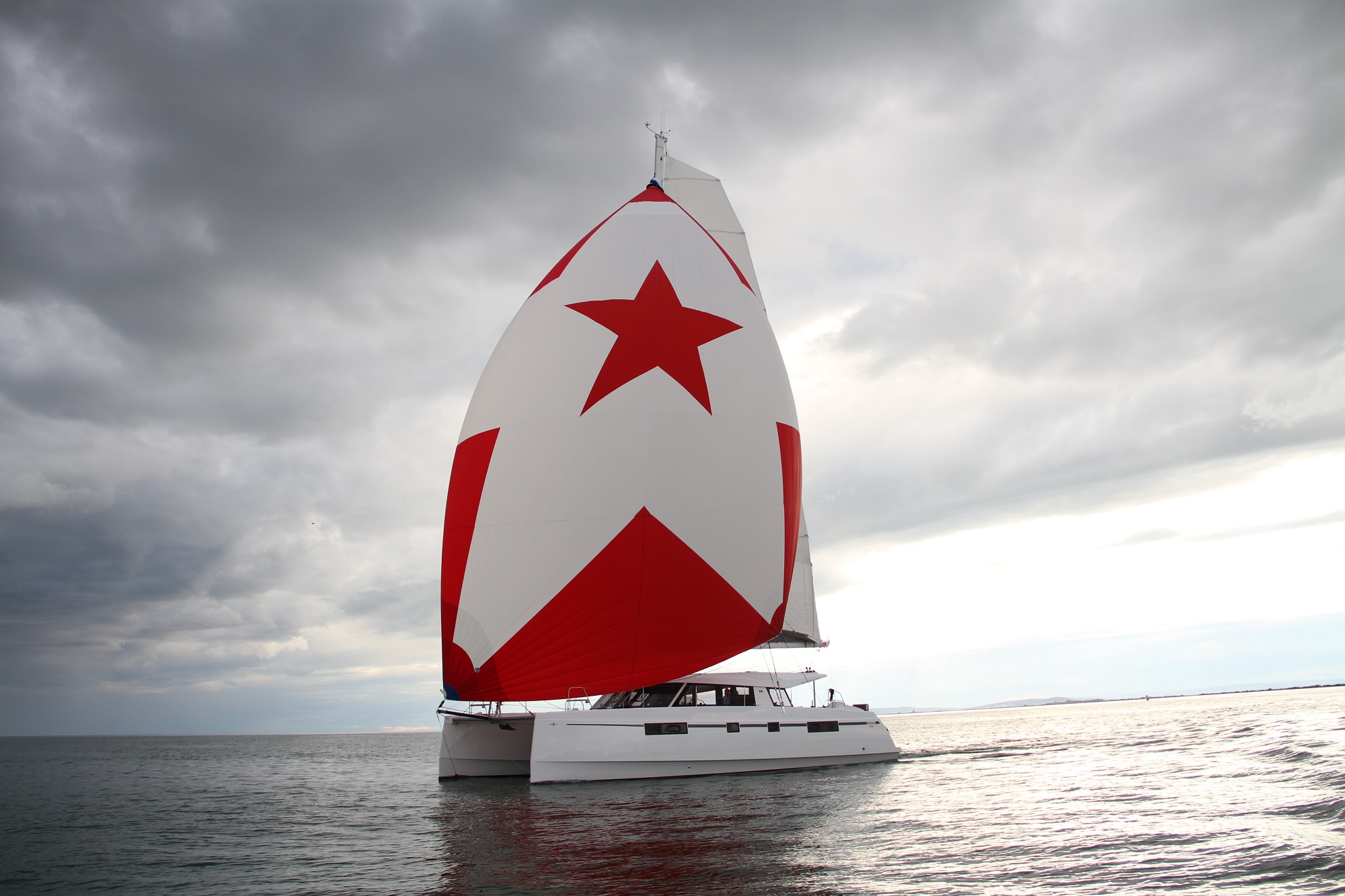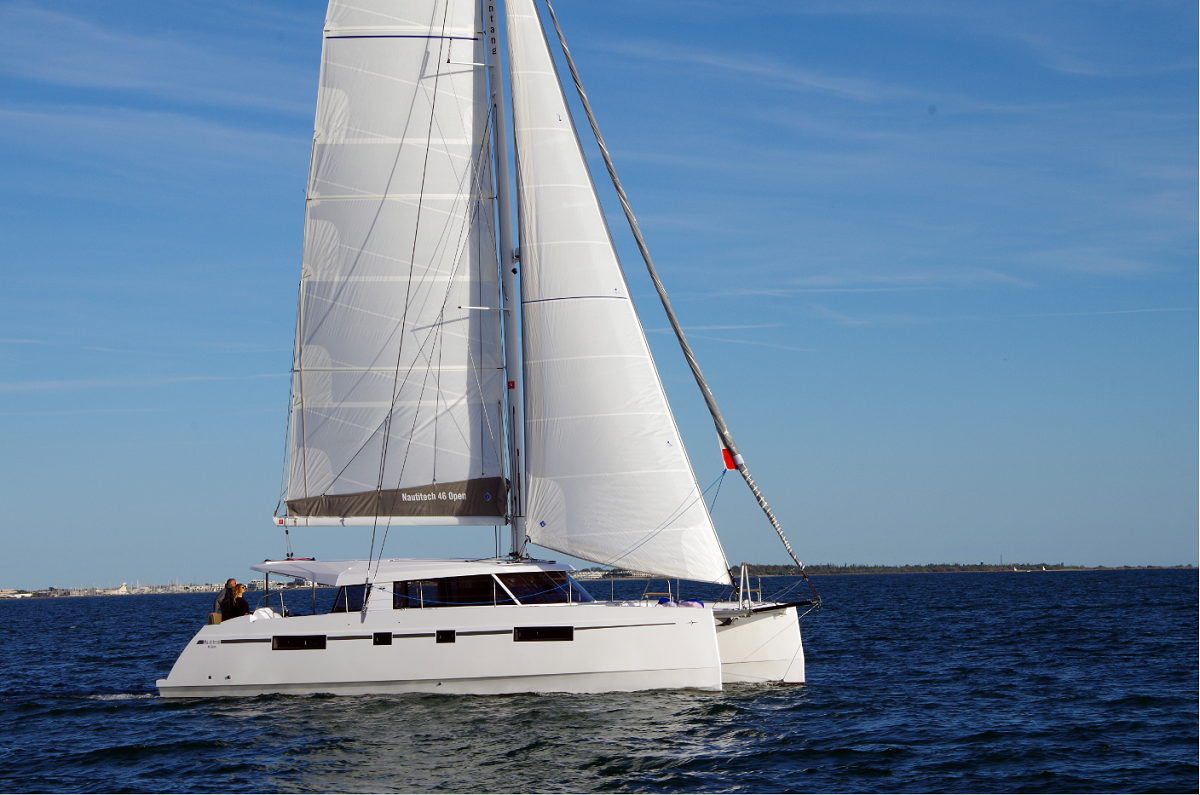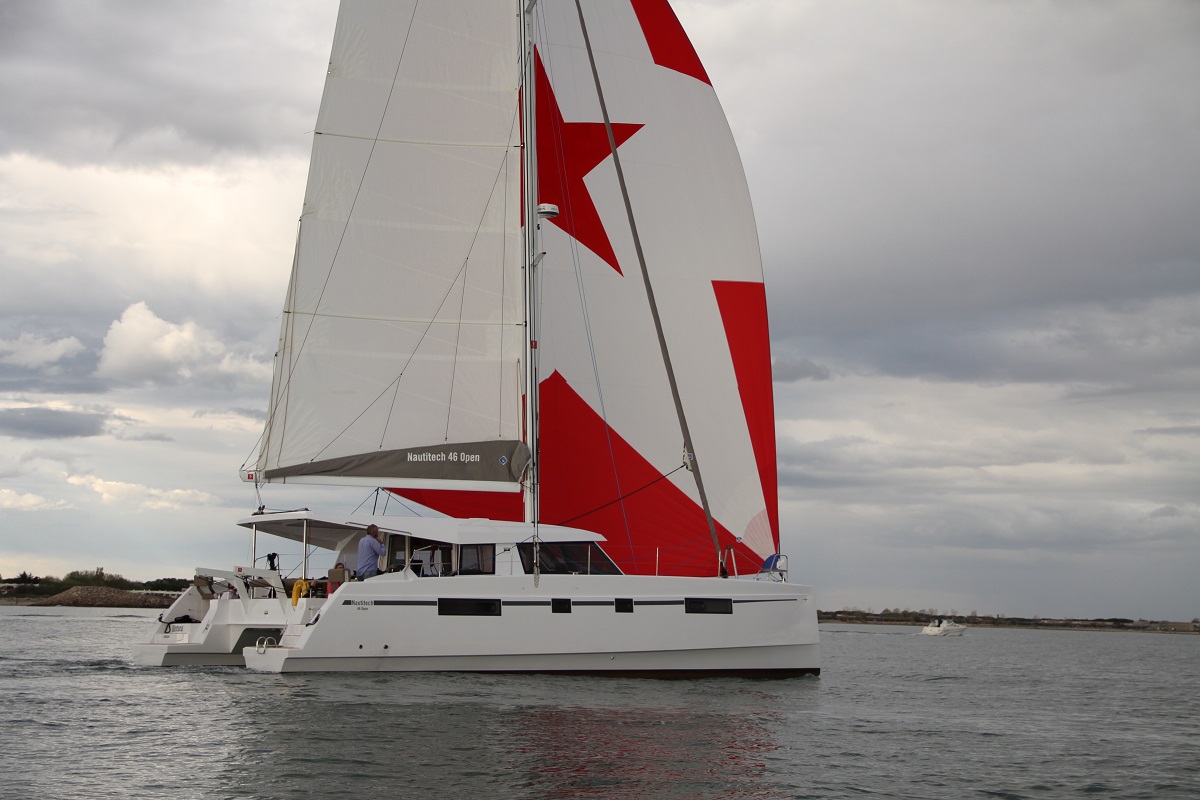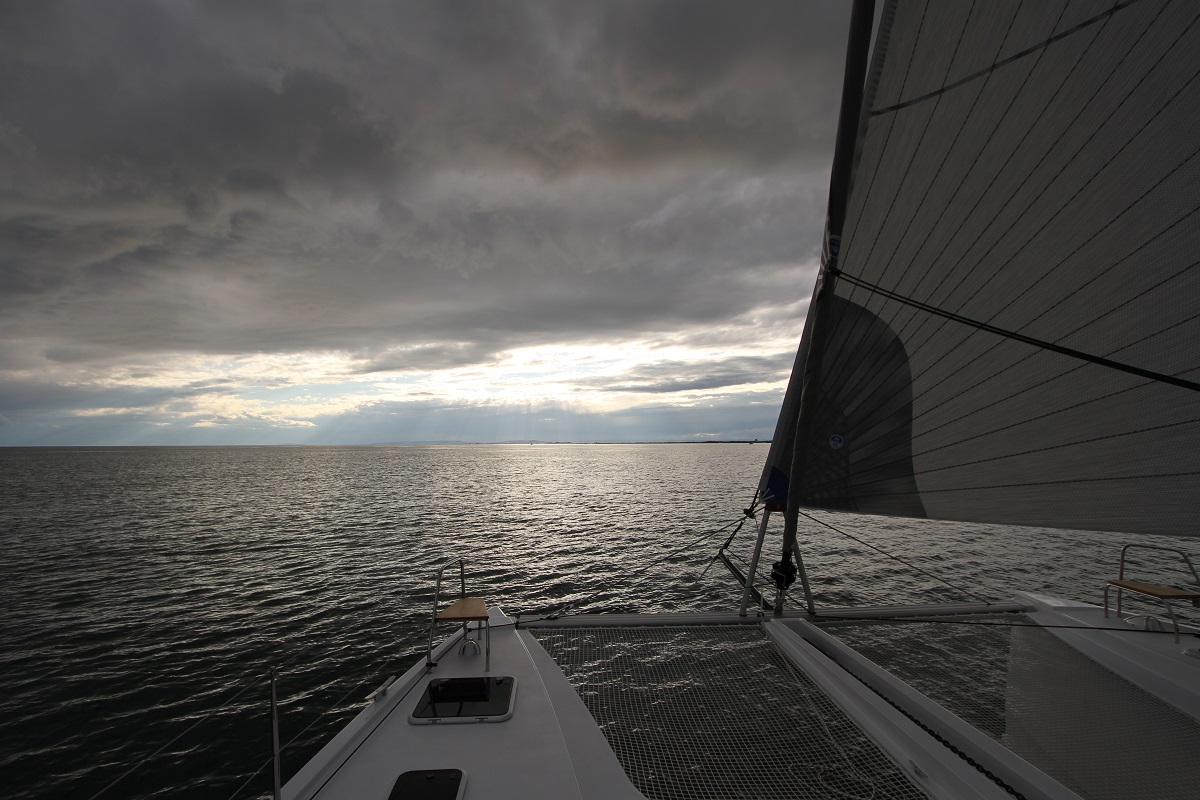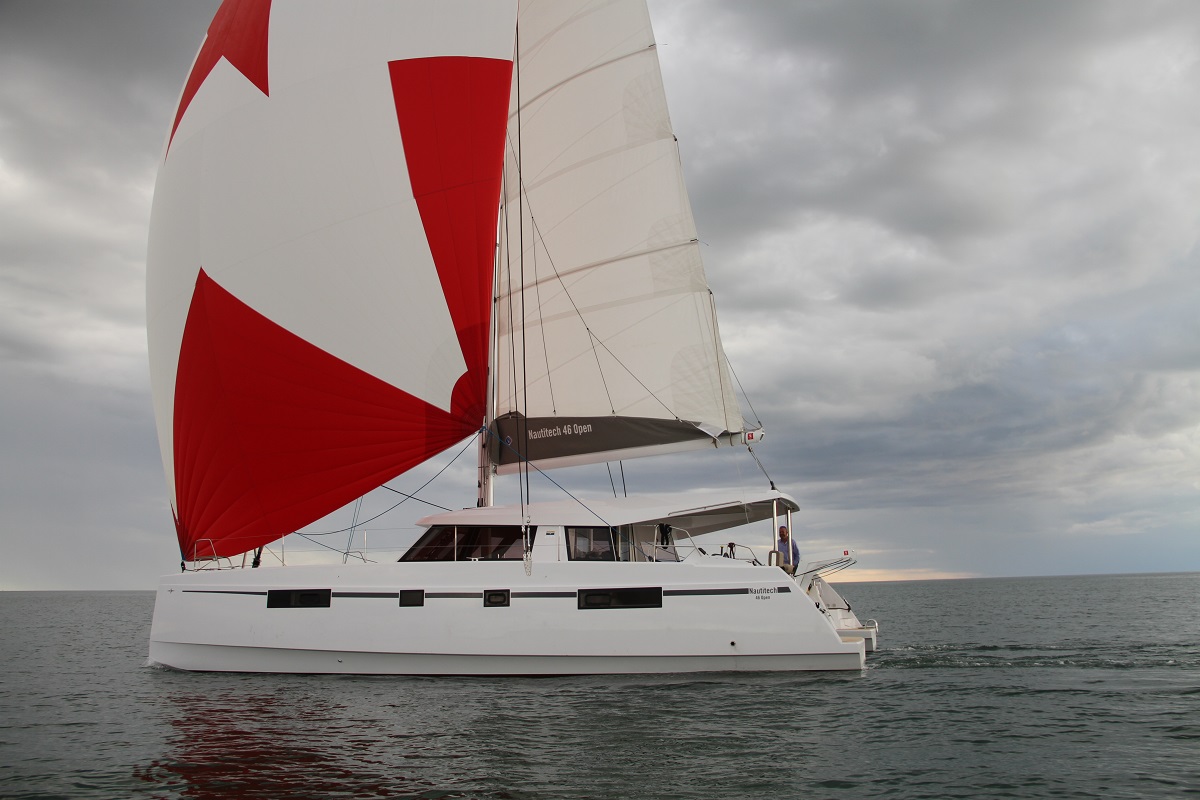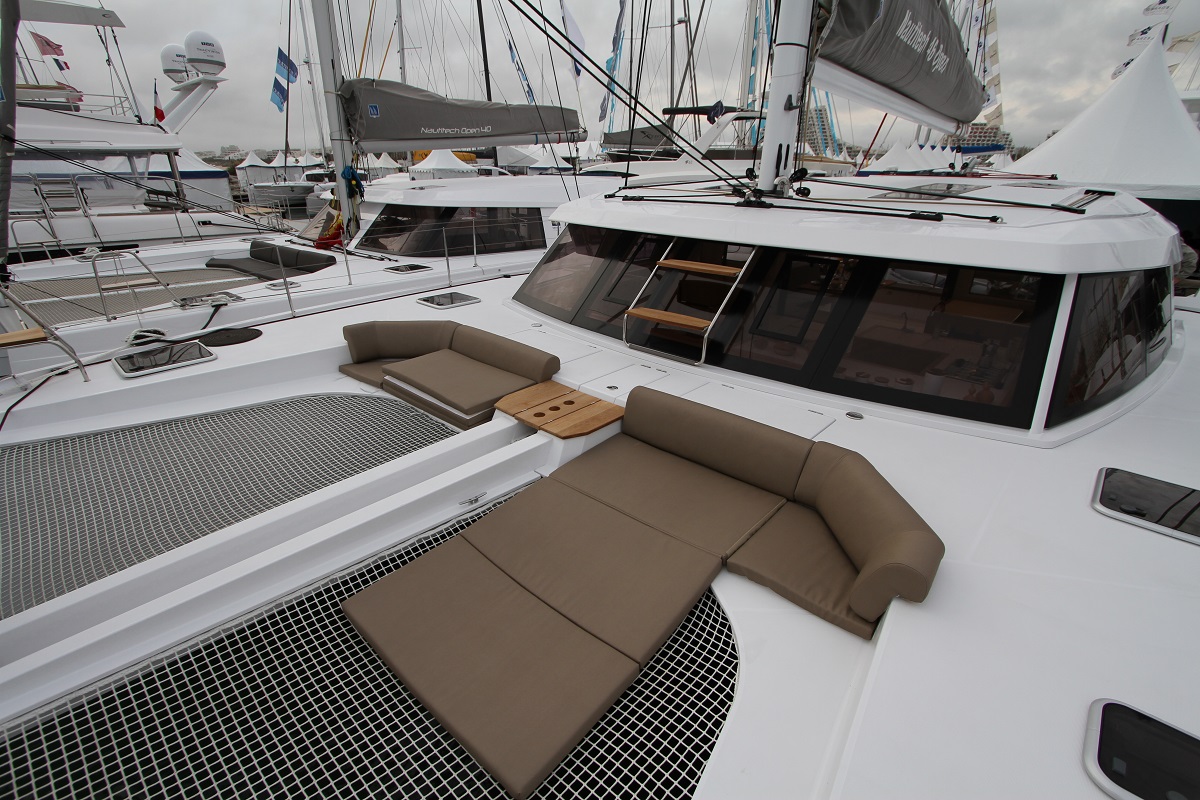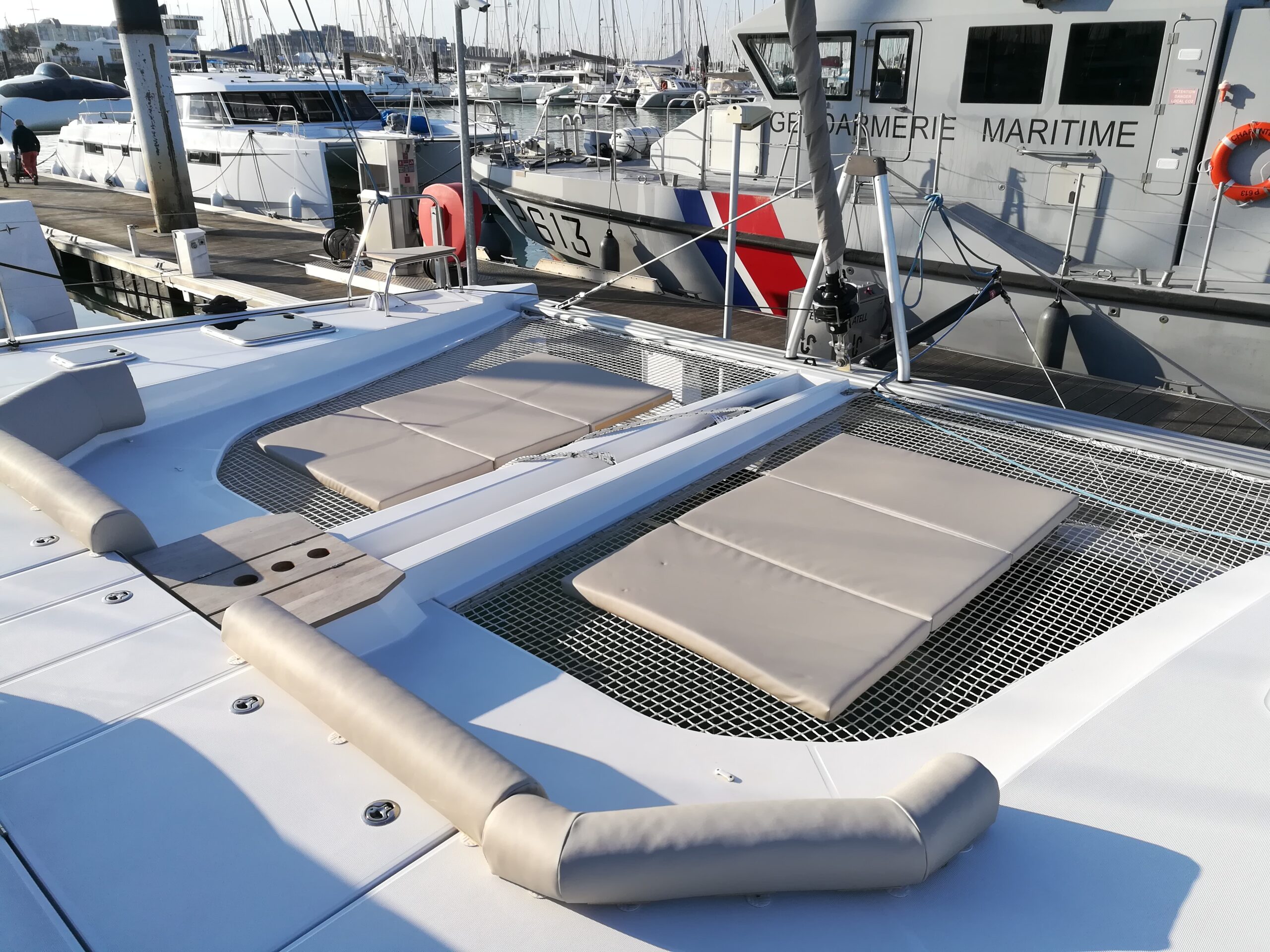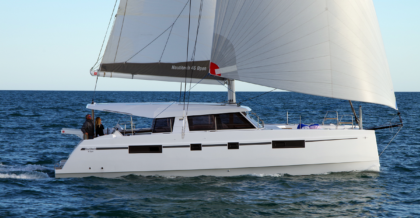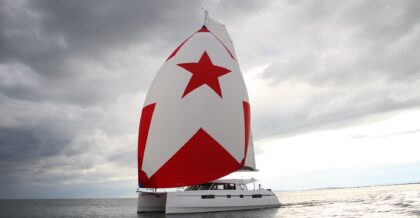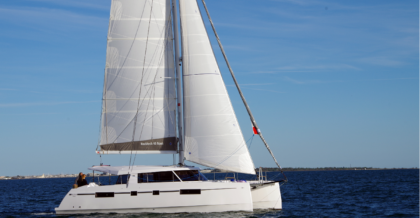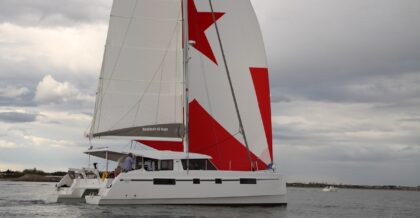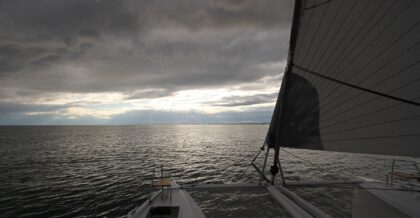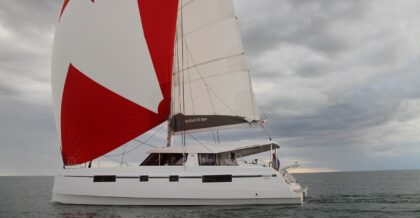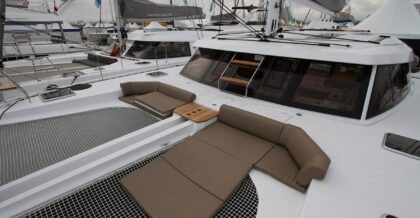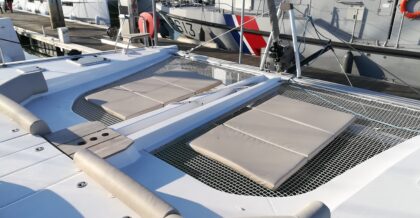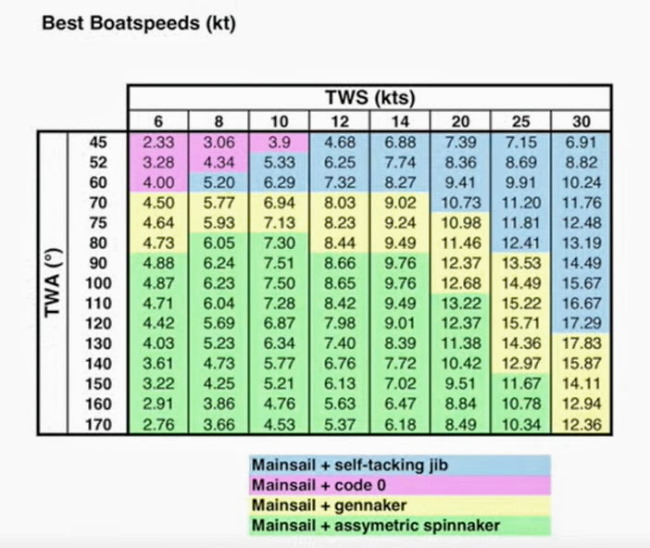 Relaunched in 2019, the Nautitech 46 Open was the Open 40’s big sister – both models were designed by Marc Lombard with a nice balance between performance and comfort. If you are looking for a sportier production cat- this is it. Nautitech have now replaced this model with the 44 and the 48.
Relaunched in 2019, the Nautitech 46 Open was the Open 40’s big sister – both models were designed by Marc Lombard with a nice balance between performance and comfort. If you are looking for a sportier production cat- this is it. Nautitech have now replaced this model with the 44 and the 48.
She has twin aft helms like the Nautitech Open 40 with great visibility forward and lots of attachment points for safety. In the larger size, there is also an option for a flybridge version. We prefer the Open with the lower boom.
Going forward from the helms, she has prominent grab rails to step up to the side deck (like the smaller boat) as well as a long deep hand hold (gutter) along the length of the coach roof to grab onto with nice wide decks so there is no ducking under the shrouds.
Access to the engines is good- the engine bay area is bigger than average and it’s easy to get into all of the areas you need to for maintenance. And one of the benefits of those aft helms is that the steering mechanism is well thought out and directly connected. You are right by the rudders after all, the system can be simple and very effective.
Since Nautitech became part of the Bavaria Group, the quality of the finish inside took a step up. The furniture is well made throughout and looks solid and hard wearing.
Pros
- Great visibility and sailing feel from those twin aft helms. Compared to, say, a Catana, you feel secure tucked in at the helm with substantial seats and high sides to lean your arm on. There is an option for a bimini back here too.
- All the lines come back to the helm, so you can do all of your reefing from the back of the boat (unlike the smaller 40).
- That Open concept plus the aft helms means that you have a huge living space for a 46 foot boat when you slide the saloon doors wide open. And inside, you have about twice as much space as the 40 with a proper nav station. It feels big.
- There are lots of rails and clip-on points everywhere. This boat feels safe to move around on.
- Large engine bays means it´s easy to get access to the twin Volvos.
- She´s quick! The 46 weighs considerably less than the competition. She accelerates quickly and has a very respectable top speed for a production cat. You should see low and even mid teens off the wind in decent conditions. You might even do the odd 20 knot surf.
- Quality interior finish.
- With that low boom, she feels very seaworthy in a blow.
Cons
- The flip side to those aft helms is reduced visibility, especially to the opposite bow. They will be exposed too, in a blow, but it´s the age old debate. In a storm you´d be tucked up inside the saloon helming from the nav station. You might want to carry autohelm spares for ocean crossings though.
- Because Nautitechs are shaped for speed by Marc Lombard, the hulls are slender compared to other production cats like the Lagoons and Fountaine Pajots. There is less space down below: that is your trade off. Having said all of that that, if you have the Owner´s version, I don´t think you´ll be complaining about the living space.
Charter a Nautitech 46 Catamaran
Are you looking for a Nautitech 46 Open or Fly to charter?
Browse our selection of high quality yachts for rent below ⇓
Rent a Nautitech 46
Find Nautitech Catamarans for charter.
All | Bali |
Sailing
The other big difference between the 46 and her smaller sister is in the running rigging. On the 46, all of the lines (halyard, reefing, topping lift etc) are lead aft back to the helms which makes for a much better experience when you are reducing sail. The 3rd reef, topping lift and furler for the headsail come back on the port side, the rest comes back on starboard.
On the 40, someone has to go upfront to the mast to reef. This is something I am looking to address on our boat- hopefully it should be fairly straightforward to change the set-up.
Like the 40, the designers and builders have worked hard to keep the weight down, so although this is a cruising cat she has one eye on performance- you can tell that from the profile of her hulls and the sail plan. This is a boat that should clock off 200 plus miles in 24 hours in the right conditions, particularly if you have the bowsprit option with gennaker and code-0. The polars show a speed of 15 knots in 25 knots of true at 110 degrees to true. I can believe that, with experience of the 40, but you would probably want to back off that and sail at 11 knots in those conditions to keep your heart rate down.
Engines On
Engine power is from twin 40hp Volvo Penta diesels with sail drive transmissions and sufficient capacity to give a range of several hundred miles and more if you are motor sailing or alternating engines. There is an option to upgrade these.
In calm conditions, one engine at 2.200 RPM will push you along at just over 6 kts SOG. Stick the other engines on and you will get close to 8 kts: she slips through the water nicely.
Just like the 40, we would advise going for throttles on both sides if you can manage it in your budget.
The Saloon
Step though into the saloon and you will see the biggest change in the refreshed design. The look we saw was dark oak (very smart) with great 360 degree views around and one huge interconnected space with the aft cockpit / dining area when you throw those double doors open.
That´s the benefit of those aft helms of course (the Excess 11 is another yacht that has gone for this set-up).
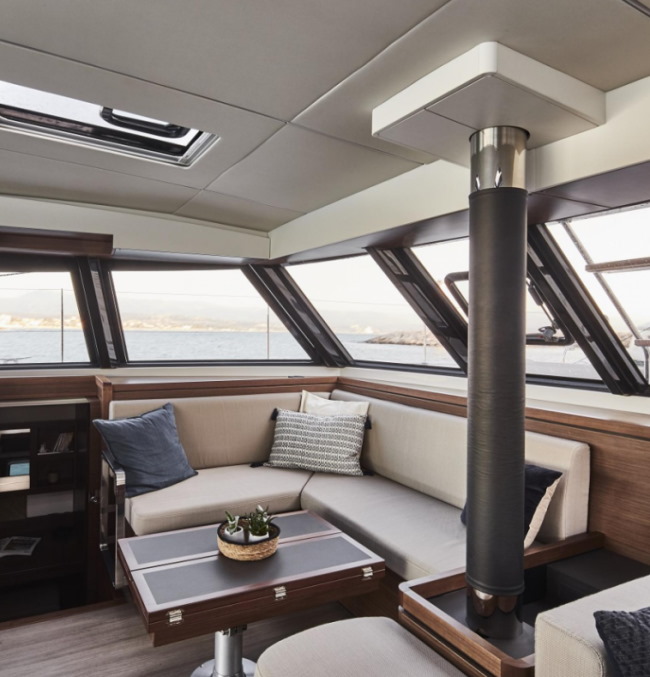
To port is a horse-shoe galley facing aft connected to the outside space and forward is a nav station to starboard and a big ‘L’-Shaped sofa to port wrapped around a folding extendable table. There’s a double fridge opposite the sofa. With 2 skylights above, you have great visibility of the sails.
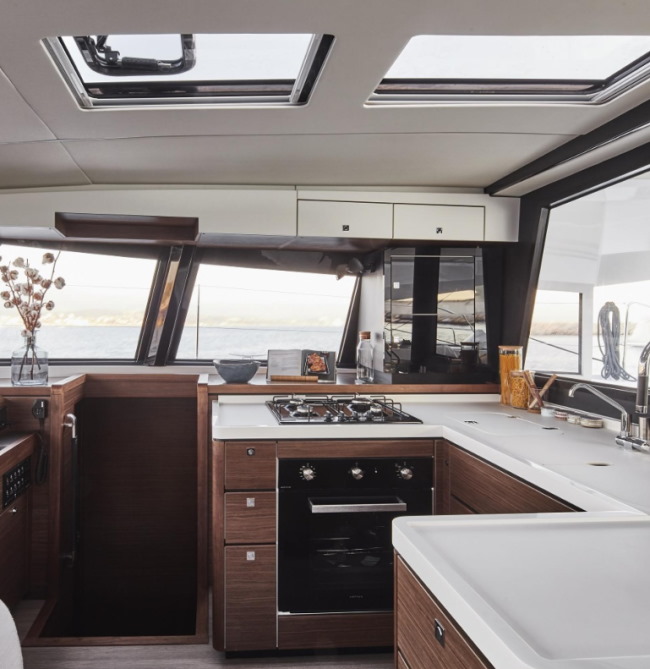
This whole area is where you’ll notice the biggest difference between the 46 and 40, it´s about twice the size.
Down Below
Things have really smartened up down below, particularly in the owner’s version. In the port hull, there’s a big semi-walk-around bunk in the owners cabin with a huge window in the hull, plus ventilation from hatches above and aft.
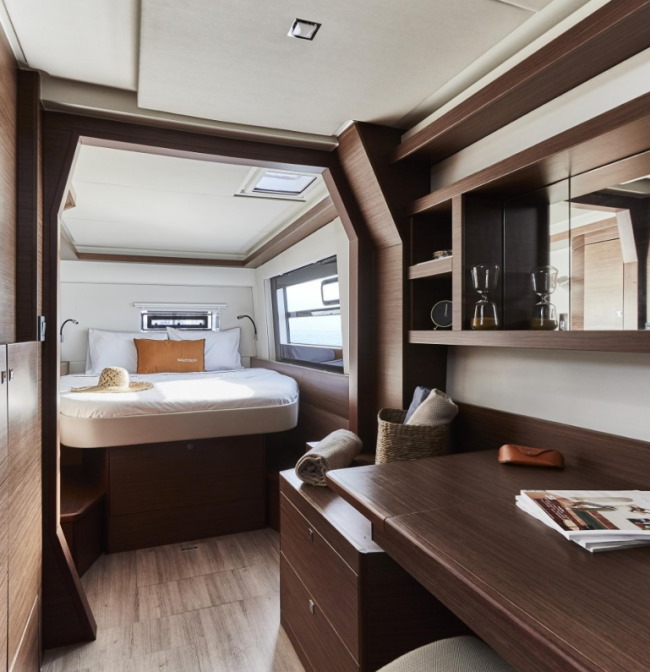
The finish looks very smart here. Forward is a head, and walk past that you are into a huge walk in shower room with double basins. The 4 cabin version is the same on both hulls: cabins fore and aft each with their own head and shower space, semi en-suite if you like.
Polar Diagram Nautitech 46 Open
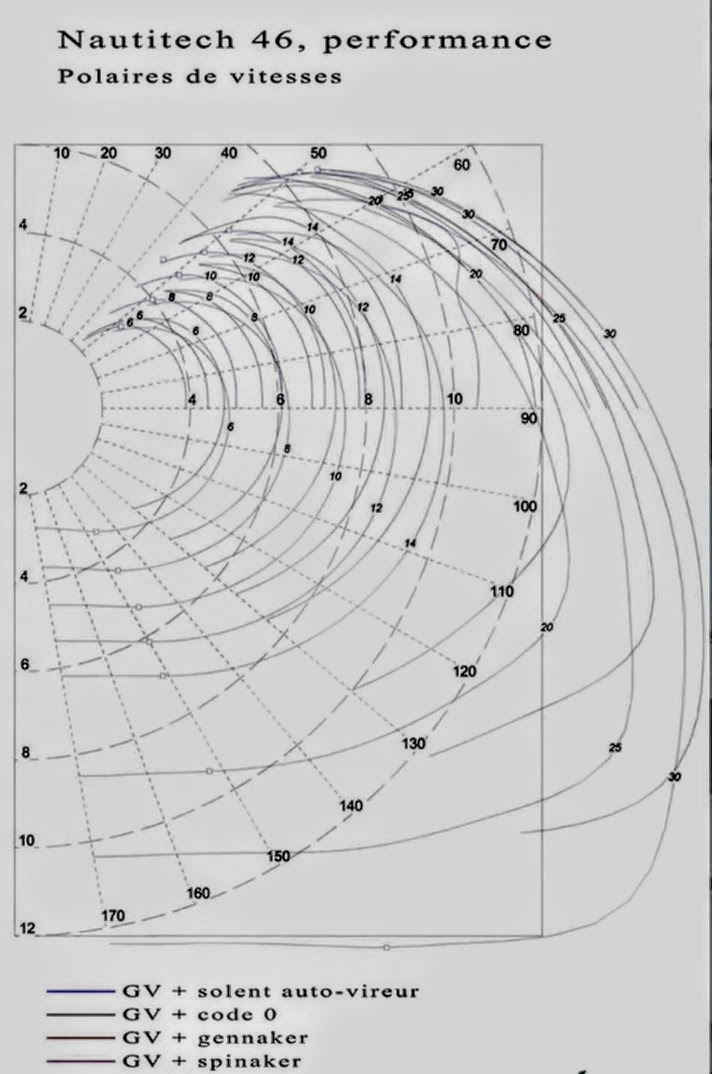
In Conclusion
A roomy, nippy boat that has smartened up even more thanks to a 2019 refresh in the interiors.
The twin aft helms won’t suit everyone, but personally we love this set up. It gives you a real monohull feel (without the heel of course) with the helms directly connected to the rudders, and it opens up a huge space between the saloon and cockpit that is particularly suited to warmer climes. It´s easy to keep an eye on everyone and easy to dock. On longer passages, you´ll be helming from the nav station and coming out to reef.
With the covers pulled down in the aft cockpit and the heating system on, it warms up quickly in there as well, or you just retreat into the saloon which is more than big enough on this longer catamaran.
We´d also recommend a look at our Knysna 500 catamaran review is you are looking at sportier cats in this size range.
Nautitech 46 Open Brochure
View the Nautitech 46 Open Brochure
FAQs
How much is a Nautitech 46 Open? What’s the Price?
You can no longer buy the 46 new as this model has been replaced by the 44 and the 48. on the second hand market, you are looking at something between €500k and €700k depending on the age, condition and VAT status.
Why Doesn’t the Nautitech 46 Have Daggerboards?
The one area where the Nautitech 46 comes up short compared to cats like Catanas is upwind performance. They have fixed keels and won’t point as high into the wind. But to be fair, they are not trying to compete with a Catana or Outremer. Nautitechs are fast production cruising cats that are priced below the performance multihulls. They sit somewhere between a Fountaine Pajot and a Catana. Having no daggerboards does have its advantages – there is more room downstairs, they are simpler to sail and arguably safer in a collision. Just ask Balance who produce their boats with and without boards for that very reason.
Contact Katamarans
Share your details with us and we’ll be in touch to discuss further.
"*" indicates required fields
